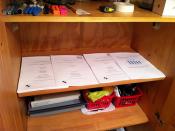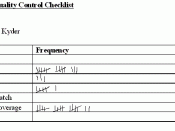Downtime to an organization means loss of profit if production schedules can not be maintained at levels expected for profitability. To introduce my paper I will focus on the use of check sheets by organizations as a management tool.
Organizations mainly use check sheets as a tool for reducing or eliminating downtime (Bothe, 2001, para. 1). Machines, computers, copiers, or other pieces of equipment invariability break down or fail. Anticipating or eliminating breakdowns or failures can mean not only a cost-savings in terms of downtime but in profitability too. To anticipate or eliminate downtime organization often use check sheets as management tools.
Check sheets are columnar forms, designed by the user, to gather data to affect the usefulness of the information being sought. Check sheets are most often effective when recording data that involves counting, classifying, or locating materials (Juran, 1990, para. 1). There are various types of forms which a check sheet can take on, each often dependant upon what type of data and what type of organization is using the data.
First there is the tally chart. Most often used to tally or count occurrences in which an event happened or did not happen. Most often used by production line organizations. Secondly is the location plot, which simply is diagramming a picture of an item which is being examined, most often for flaws or defects, and plotting out where the flaws or defects occur on the diagram. Most often used in the textile or manufacturing organizations. Thirdly is the check list, which is used to indicate items which have been completed instead of counting problems. This tool is especially helpful in simplifying documentation. Most often used by design firms or organizations. Lastly is the process distribution chart, which charts out performance of processes to be analyzed as...


